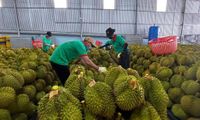The Thai Rice Exporters Association (TREA) has reported a significant decline in rice exports, with the first three months of 2025 (B.E. 2568) seeing only 2.1 million tons shipped, representing a 30% decrease compared to the previous year. This downturn is attributed to increased competition from India, which has resumed exporting white rice after a two-year hiatus, and Indonesia, a major importer that has halted rice imports due to a surplus in its domestic production.
Mr. Chookiat Ophaswongse, the Honorary President of TREA, explained that Indonesia, which imported as much as 4 million tons last year, is expected to import less than 1 million tons this year. This shift is projected to decrease overall rice exports by 53%. However, the demand for Thai Hom Mali rice and glutinous rice has seen an uptick, providing some relief amidst the declining figures.
Looking ahead, TREA maintains an ambitious target of 7.5 million tons for the year, although this will be reassessed mid-year. The association is closely monitoring the situation as external factors, including U.S. tariffs, could impact future exports. The implementation of the "Trump 2.0" policy has already seen a 10% tariff on Thai imports, up from 0%, and a potential increase to 25% could further complicate matters.
Currently, the price of Thai Hom Mali rice stands at $1,000 per ton, but should tariffs rise, this could escalate to $1,250 per ton, raising concerns about whether U.S. consumers will accept these higher prices. In the first quarter of this year, Thailand exported over 200,000 tons of Hom Mali rice, and last year, total rice exports to the U.S. reached 830,000 tons, with Hom Mali accounting for 630,000 tons of that total.
Despite the challenges, the Thai government remains optimistic about the rice export sector. Mr. Phichai Naripthaphan, the Minister of Commerce, has stated that the ministry is confident in achieving the export goal of 7.5 million tons. Recent efforts include opening new markets, such as a successful sale of 400,000 tons of rice to South Africa.
In contrast, Vietnam's agricultural sector is also navigating a complex landscape as it adapts to shifts in the global supply chain and international trade barriers. The Ministry of Agriculture and Rural Development (MARD) has indicated that while these challenges exist, they also present opportunities for Vietnam to pivot towards emerging markets.
In 2024, Vietnam is projected to export $51.7 billion worth of goods to Europe, a notable increase of 18.5% from 2023. The Philippines is set to become Vietnam's largest rice importer, with an estimated import volume of 3.6 million tons, accounting for 40% of the nation's total rice exports.
The EU has emerged as a significant partner following the Vietnam-EU Free Trade Agreement (EVFTA), which has facilitated better market access for Vietnamese agricultural products, including rice, coffee, and seafood. Deputy Minister Phung Duc Tien highlighted the rising demand for halal food in markets such as Israel, the UAE, and Saudi Arabia, indicating a strategic opportunity for Vietnam to enhance its export value.
Mr. Nguyen Hoai Nam, Deputy Secretary General of the Vietnam Association of Seafood Exporters and Producers (VASEP), noted that both the quality and quantity of Vietnamese products are improving, positioning the country favorably in the competitive global market.
As part of its strategy to diversify markets, Vietnam is also eyeing opportunities in emerging regions like Africa and Latin America, where there is a growing demand for processed foods, seafood, and tropical fruits. However, challenges remain, particularly in meeting the stringent quality standards required by markets such as the EU and Japan.
In summary, while both Thailand and Vietnam face hurdles in their rice export sectors, they are actively seeking to adapt to changing market conditions. Thailand's TREA is focused on maintaining its export targets despite external pressures, while Vietnam is leveraging new opportunities in diverse markets to enhance its agricultural output.
As the global agricultural landscape evolves, both nations will need to navigate these changes carefully to sustain their positions as leading rice exporters in the region.


